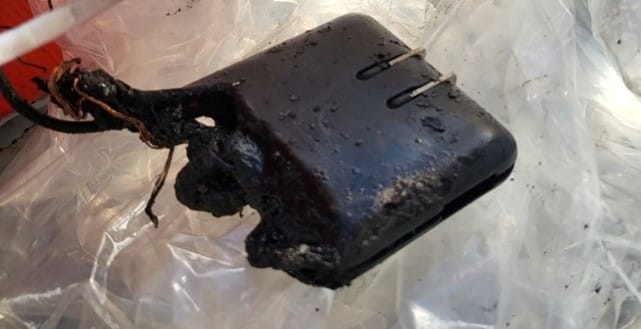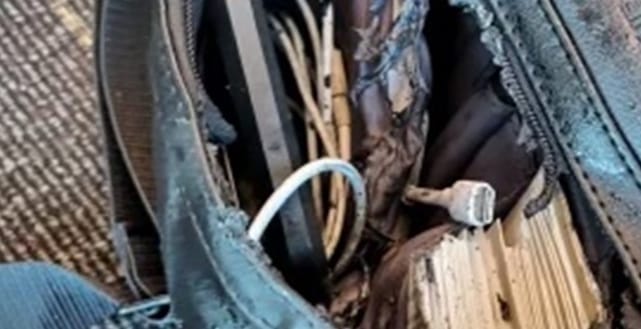Cabin Fire in Aviation: A Detailed Case Study on Risk Management and Safety

In aviation, ensuring passenger and crew safety is paramount. Among the various threats that can arise mid-flight, cabin fires, particularly those sparked by lithium battery devices, have become one of the most challenging risks for airlines to manage. As society’s reliance on portable electronic devices grows, so too does the likelihood of these devices being the source of in-flight fires.
This case study takes a deep dive into a specific incident involving a cabin fire on a Boeing 737, exploring the effectiveness of the existing safety measures, the challenges encountered by the crew, and the broader implications for the aviation industry.
Incident Overview: The Fire on the B737


The incident in question occurred shortly after the aircraft had taken off. Just 3-5 minutes into the flight, an auxiliary battery device belonging to a passenger in the first-class cabin spontaneously caught fire.
The cabin crew, well-trained in emergency response, immediately began to execute their fire-fighting procedures as outlined in the airline’s safety protocols. Despite their prompt response, the situation quickly intensified as thick, dense smoke began to fill the cabin.
The Challenges: A Closer Examination
While the crew successfully contained the fire, the incident revealed several significant challenges that complicated their efforts. These challenges provide valuable insights into the areas where safety protocols and equipment could be improved.
- The Density of Smoke: The most immediate challenge faced by the crew was the density of the smoke that quickly filled the cabin. Thick smoke can drastically reduce visibility, making it difficult for crew members to locate the source of the fire and the necessary firefighting equipment. Moreover, the presence of dense smoke increases the risk of smoke inhalation, not just for passengers, but for the crew themselves. In such situations, every second counts; any delay in responding to the fire can exacerbate the situation, increasing the danger for everyone on board.
- Equipment Accessibility and Usability: The effectiveness of firefighting efforts depends heavily on the accessibility and usability of the equipment provided. In this incident, the crew encountered difficulties with the thermal containment bags designed to isolate and contain burning devices. Opening these bags and breaking the seal that held the gloves proved challenging under the urgent conditions. The gloves themselves, which are intended to protect the wearer from burns, were found to be bulky and hindered the crew's ability to handle the smoking device effectively. These difficulties not only delayed the firefighting process but also heightened the risk of the fire spreading.
- Protective Breathing Equipment (PBE) Use: Protective Breathing Equipment is designed to safeguard the crew from inhaling harmful smoke and fumes during a fire. However, in this incident, the responding crew reported that they did not have sufficient time to don the PBE. The urgency of the situation meant that the crew had to prioritize extinguishing the fire over their own protection, leading to their subsequent hospitalization. This raises critical questions about the design and deployment of PBE—should the process of donning this equipment be streamlined to ensure that crew members can protect themselves without sacrificing response time?
Organisational Lessons Learned: Pathways to Improvement
In the wake of the incident, a thorough review was conducted to identify lessons learned and to make recommendations for improving safety procedures and equipment.
These lessons are not just applicable to the airline involved but offer valuable insights for the wider aviation community.
- Enhancements to Thermal Containment Bags: One of the key recommendations was directed at the manufacturer of the thermal containment bags. It was suggested that the size of the seals be reduced, allowing for easier access and faster deployment. The gloves, which were found to be too bulky, should also be reviewed with the aim of improving dexterity. This would enable crew members to handle smoking or burning devices more effectively and with greater precision.
- Correct Equipment Allocation and Verification: An error was discovered in the equipment loaded onto the aircraft—an incorrect thermal containment bag had been boarded. This prompted a fleet-wide campaign to verify that all aircraft were equipped with the correct safety gear. This incident highlights the importance of rigorous pre-flight checks and the need for airlines to ensure that all safety equipment is properly allocated and in place before takeoff.
- Improved Visibility of Emergency Equipment: During the incident, locating the necessary equipment in the dense smoke proved to be a challenge. To address this, the airline recommended the introduction of photoluminescent emergency equipment placards. These glow-in-the-dark signs would make it easier for crew members to quickly locate and access emergency equipment, even in low-visibility conditions.
Global Recommendations for the Aviation Industry
The lessons learned from this incident are not just limited to the airline involved; they have broader implications for the aviation industry as a whole. To enhance safety and ensure that all operators are prepared for similar incidents, the following recommendations have been made:
- Strategic Placement of Firefighting Equipment: It is crucial that firefighting equipment is correctly allocated across all cabin sections. This ensures that no matter where a fire breaks out, the crew can quickly access the tools they need to manage the situation.
- Targeted Training for Cabin Crews: Training programs for cabin crews should be designed to address the specific challenges and deficiencies identified in this and similar incidents. By focusing on the practical use of firefighting equipment and the challenges posed by dense smoke, airlines can better prepare their crews for real-life emergencies.
- Accessibility and Visibility of PPE: Operators should critically assess how accessible and visible firefighting equipment, particularly Personal Protective Equipment (PPE), is during an emergency. The ease with which crew members can locate and don PPE in extreme conditions can significantly impact the outcome of a fire incident.
- Passenger Education and Risk Mitigation: Finally, passengers must be educated on the risks associated with battery-equipped devices. Airlines should take a proactive approach in reminding passengers of these dangers and encourage them to minimize the number of electronic devices they bring on board. Reducing the number of potential fire hazards can significantly lower the overall risk.
Conclusion: A Call to Action
The cabin fire on the B737 serves as a stark reminder of the risks associated with modern air travel and the importance of rigorous safety measures. While the crew’s response was commendable, the challenges they faced reveal critical areas for improvement.
By implementing the recommendations outlined in this case study, airlines can enhance the safety of their operations, better equip their crews, and ultimately protect the lives of their passengers.
This incident is not just a lesson for the airline involved but a call to action for the entire aviation industry to reassess and strengthen their safety protocols in the face of emerging risks.